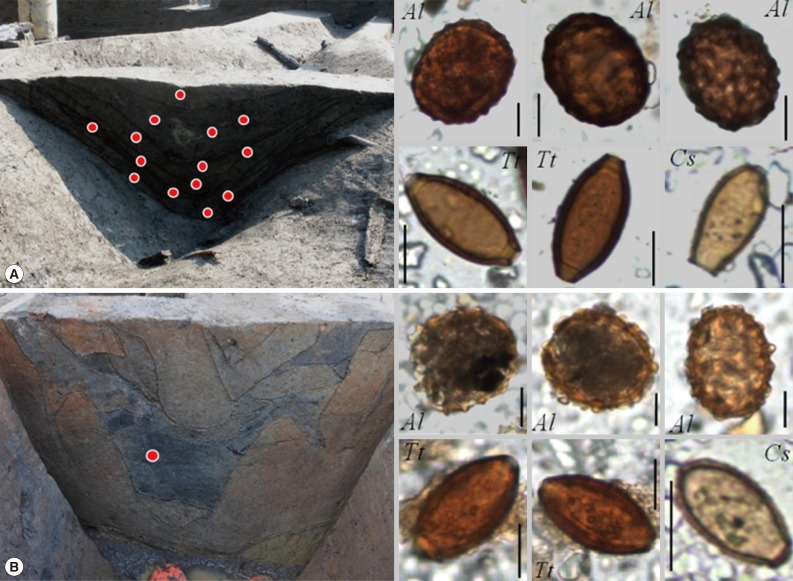V-shaped Pits in Regions of Ancient Baekje Kingdom Paleoparasitologically Confirmed as Likely Human-Waste Reservoirs
Article information
Abstract
In a paleo-parasitological analysis of soil samples obtained from V-shaped pits dating to the ancient Baekje period in Korean history, we discovered Ascaris lumbricoides, Trichuris trichiura, and Clonorchis sinensis eggs. In light of the samples' seriously contaminated state, the V-shaped pits might have served as toilets, cesspits, or dung heaps. For a long period of time, researchers scouring archaeological sites in Korea have had difficulties locating such structures. In this context then, the present report is unique because similar kind of the ancient ruins must become an ideal resource for successful sampling in our forthcoming paleoparasitological studies.
Effective disposal of human waste undoubtedly was instrumental to the maintenance of public health in pre-modern towns and cities. Archaeologists have shown how in the English city of York, structures such as stone-built sewers were integral to that function [1]. Presumably, effective night-soil disposal also was a top priority for contemporaneous East Asian urban dwellers [2,3]. Whereas ancient-parasite-egg contamination of soil samples taken from sewer- or toilet-like structures might be the effect of some sort of simple diffusion from outside areas, it is actually more probable that those structures had in fact been cesspits or toilets.
In fact, the remnants of some East Asian cesspits already investigated have been confirmed, by the presence of helminth eggs in soil samples, as having been used as human-waste reservoirs [4]. In East Asian agrarian societies, fertilizer in the form of night soils periodically carted away from urban sites to surrounding farms was widely used [2,3,4]. In the case of Korea though, there are very few reports on historical structures that could be conjectured to have seen use as toilets or cesspits. This makes information on the sanitary status of pre-modern Korean cities particularly difficult to obtain.
Finally however, in 2004, Korean researchers located presumptive toilet structures amid the royal palace ruins of the ancient Baekje Kingdom (18 BCE-660 CE) (the Wanggung-ri site), from which structures they obtained soil samples found to contain a significant number of ancient helminth eggs (Fig. 1) [5]. This discovery has served to intensify the academic controversy surrounding the identification of toilets and cesspits and their probable uses in historical Korean towns and cities. In any case, it is certain that structures confirmed to have been cesspits and toilets undoubtedly will prove, and are proving to be, ideal resources for paleoparasitological studies [6]. In this light, it is expected that our current cases also will be meaningful to Korean paleoparasitologists and their investigations.

(A) Ancient Korean kingdoms (Goguryo, Silla, and Baekje). (B) Magnified image of green rectangle area. a, Gua-ri; b, Gatap-ri. In both sites of 'a' and 'b', the toilets or cesspits could be identified by paleoparasitological examinations.
In a recent archaeological study on Buyeo, the capital of the ancient Baekje Kingdom, we found candidate cesspit and toilet ruins that yielded many soil-transmitted helminth eggs. We believe that our investigation likely will prove to be significantly revelatory on the use and maintenance of toilets and cesspits in ancient Korean towns or cities. On that basis, we will report herewith.
The soil samples (n=57) examined in this paleoparasitological study were collected from geological strata at archaeological sites (Gua-ri 319 and Gatap-ri, Dusireoggol remains) in Buyeo, the capital of the ancient Baekje Kingdom (Fig. 1). The strata were dated to the Sabi period (6th-7th century CE). At this time, Gua-ri 319 was centrally located in a residential area of Buyeo marked by puddles and ditches. Owing to the low and moist topography there, many wooden relics could be excavated. At Gatap-ri, the Dusireoggol remains, remnants of residential areas, roads, and water-catchment facilities were excavated (Fig. 2). The number of eggs per g of feces (EPG) was calculated by multiplying 10 times to the average number of eggs counted in soil samples considering that 10 g of soils were dissolved in 20 ml of 0.5% trisodium phosphate solution per each sample. An overall data summary is provided in Table 1.

(A) A photograph of Gua-ri 319 remains. Helminth eggs were recovered from the construct XII (arrow). (B) An aerial photograph on the Dusireoggol remains, Gatap-ri. BD, building; R, residential area; W, water collecting facility; RD, road. The helminth eggs were recovered from the construct suspected as the toilet (arrow).
At Gua-ri 319, we collected samples (n=56) at 5 different points, some of which were inside of a V-shaped pit. At Gatap-ri, only 1 sample was obtained from a V-shaped pit. The samples were taken using conical tubes (Falcon Plastics, Los Angeles, California, USA) driven into the soil strata. Surface-soil samples for use as negative controls also were taken.
Back at our laboratory, a contamination-minimization protocol entailing the wearing sterilized gloves, head caps, and masks was followed. The samples were re-hydrated in 0.5% trisodium phosphate solution [7,8] and observed in 10 µl quantities 20 times (total per sample: 200 µl) under light-microscopy (Olympus, Tokyo, Japan). Egg-size measurements were taken from 10 eggs, and the number of helminth eggs per gram (EPG) was estimated. Since 10 g of soil was dissolved in 20 ml of 0.5% trisodium phosphate solution per sample, the EPG was calculated by dividing the average number of eggs counted in each sample by 10.
Among the Gua-ri 319 samples, eggs were found only in those taken from the V-shaped pit (area XII; no eggs were found in areas XI, XVI, V, or IX). Their morphologies and sizes, typical of Ascaris lumbricoides, Trichuris trichiura, and Clonorchis sinensis, respectively, identified them as such. Significantly, the egg-bearing samples representing the Gatap-ri site, in the same Buyeo area, also were obtained from a V-shaped pit, and the species were the same; A. lumbricoides, T. trichiura, and C. sinensis (Fig. 3). The average egg dimensions and EPG for each site's samples are summarized in Table 2.

Helminth egg discovery in the samples from Gua-ri (A) and Gatap-ri (B) sites in Buyeo. (A) Gua-ri site, the construct XII. V-shaped pit could be identified. Sampling points are marked by dots. In every sample examined, Ascaris, Trichuris, or Clonorchis eggs were discovered. (B) In Gatap-ri site, V-shaped pit was also discovered. The sampling point is marked by red dot. We also discovered Ascaris, Trichuris, and Clonorchis eggs. Scale bars in each egg plate=20 µm.
A previous series of paleoparasitological studies showed how historical high-population-density towns and cities in East Asia removed human waste. For each spatial and temporal span of historical development, the pattern of night-soil removal appeared to differ [2,3,5]. In another study, paleoparasitologists investigating the Neolithic Jomon period in Japan found many human coprolites in a shell midden, indicating that those pre-agrarian people used that site and others like it as toilets, dung heaps, or night-soil reservoirs [4]. In time though, the use of toilets, even flushing toilets, came to predominate in East Asia as in other areas of the ancient civilized world [9,10], as confirmed by archaeological investigations [4]. Besides flushing toilets, a tradition of cesspit toilets was also developed in East Asia. Cesspit toilets served farmers as reservoirs for the night soils they commonly utilized as a fertilizer. Once the cesspits became full, their contents were carried away to nearby farmlands. In fact, the use of cesspit toilets in a traditional Japanese society has been verified by archaeological investigations [4].
Meanwhile, similar reports on human-waste reservoirs in Korea have been few. However, in 2004, as noted above, Korean researchers finally found toilet-like structures at the Wanggung-ri site, the location of the ruins of the Baekje Kingdom's Royal Palace. One such presumptive toilet was a 10.8 m (length)×1.8 m (width)×3.4 m (depth) pit. Also evident, significantly, was a sewage canal connecting the toilets to the Royal Palace perimeter grounds [5]. Parasitological examinations of sediments sampled from those structures, in this seminal Korean paleoparasitological investigations, revealed many Ascaris, Trichuris, and Clonorchis eggs.
In much the same way, the current study also could prove to be very meaningful to concerned researchers. We discovered many of the same species (Ascaris, Trichuris, and Clonorchis) of helminth eggs in soil samples obtained from the V-shaped pits unearthed at the Gua-ri and Gatap-ri sites in Buyeo. Unfortunately, however, final determination of their exact purpose must remain unconfirmed for now, pending the accumulation of more information, historical and otherwise, on ancient Korean towns and cities. Historical studies from other countries, however, are suggestive. In both ancient Rome and medieval London, for example, there were a number of latrines, cesspits, dung heaps and gutters wherein human waste was accumulated [11]. Likewise, it is entirely possible that the V-shaped pits investigated in the present study were used as cesspits, reservoirs, or dung heaps for the night soils of the Baekje people. We note that even in this politico-cultural center of that ancient Korean kingdom, there might well have been many such structures.
Our study established the presence of ancient helminth eggs (A. lumbricoides, T. trichiura, and C. sinensis) in soil samples obtained from V-shaped pits in Buyeo, the capital of the ancient Baekje Kingdom. Our overall results indicate that these pits might have been used as human-waste reservoirs. Whereas this is indeed a significant finding, we must also admit that the number of cesspits or toilets reported thus far for historical Korean towns or cities remains very small. Identifying and studying additional archaeological structures that once functioned as toilets or cesspits in historical Korean towns and cities, particularly those representing a variety of temporal and spatial ranges undoubtedly will facilitate the locating and collecting of ideal paleoparasitological samples.
ACKNOWLEDGMENTS
This research was supported by Basic Science Research Program through the National Research Foundation of Korea (NRF) funded by the Ministry of Education (no. 2013R1A1A2009688). SYS and MHL worked for Guari-319 site; GIL and SBJ worked for Gatap-ri as archaeologists. MJK and CSO worked for sampling in the fields; MS, JYC and DHS did parasitological examinations and paper writing.
Notes
We have no conflict of interest related to this work.

